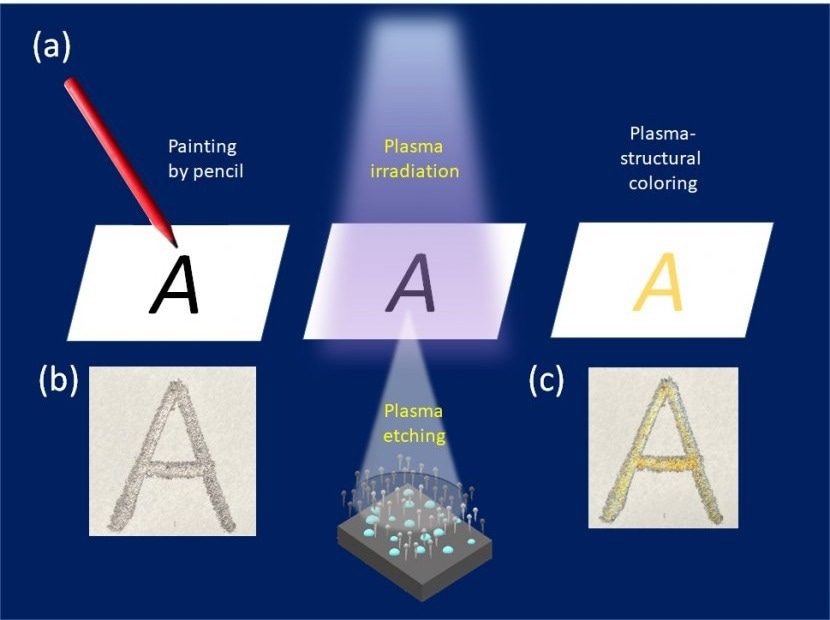Graphite can be plasma irradiated to provide structural coloring, reducing the need for hazardous colorants. The amount of time exposed to the plasma irradiation, the strength of the irradiation, and the thickness of the applied graphite layer could all be used to alter the colors produced by the plasma irradiation.
 (a) Scheme illustrating the “plasma-structural coloring”; (b) The picture of a letter “A” written by a pencil; (c) The picture of the sample after the plasma irradiation for 80 seconds. Image Credit: Shinshu University
(a) Scheme illustrating the “plasma-structural coloring”; (b) The picture of a letter “A” written by a pencil; (c) The picture of the sample after the plasma irradiation for 80 seconds. Image Credit: Shinshu University
The use of plasma-structural coloring attempts to reduce the harm that conventionally harmful dyes cause to the environment and battle it with the technology around structural colors.
Since structural colors are based on observing how the light scatters when reflected, giving the observed colors an iridescent character, they seem different from colors dyed by pigment. Peacock feathers and other insects, including beetles, exhibit this type of coloring in nature.
Most colored inks, whether they are used on paper or textiles, are harmful to the environment. A sustainable solution is required since dye production, along with the volatile chemicals that make up the colors, is a major cause of pollution. By using structural coloring produced by plasma irradiation, this solution can be visualized.
We called this technique ‘plasma structural coloring’. The method is an entirely new technique that changes the color of the penciling part on a paper by plasma irradiation. The technique is an environmentally friendly coloring method and can be applied to various activities, such as study and art.
Hiroshi Moriwaki, Professor, Department of Applied Biology, Shinshu University
The findings were released on January 11th, 2023, in ACS Applied Materials & Interfaces.
“Structural colors” are hues seen by the human eye as a result of light interference caused by reflections off the surface of nanostructured materials, such as pencil graphite. By examining materials, plasma intensity, and the amount of time needed to change the color, the study explored how plasma irradiation can modify how color appears.
The structural colors and coloring created by plasma irradiation were tested in this study. They were effective in turning graphite on paper into the colors blue, yellow, and red in accordance with the duration of exposure to plasma irradiation, consequently they had some potential.
The colors were also discovered to be angle-independent, meaning that the color seen was constant regardless of the angle from which it was seen.
Moriwaki added, “We would like to make readers understand that we have developed a simple method for the formation of structural colors at low cost and in a short time. We believe this method can contribute to the achievement of a sustainable society.”
Stability is another advantage of structural colors; unlike other dyes, they do not fade or deteriorate over time as a result of chemical interactions. Enhancing color durability will result in higher-quality work without worrying about fading in the future.
This is especially helpful in the art field, where many items need to be protected from light to maintain the richness and intensity of the colors.
Moriwaki further stated, “The ultimate goal is to spread the method of coloring pencil writing by the plasma irradiation. For that purpose, it is important to develop a simple and easy-to-use small plasma device suitable for this method. In addition, we think it would be interesting if an artist could create paintings colored only with structural colors.”
Reducing the color variability via the process is the next stage in refining the plasma-structural coloring procedure. Furthermore, a specific kind of pencil with a high graphite content is currently the most efficient instrument; thus, finding a means to adapt the procedure to a wider range of tools could also be helpful for future research.
It will also be more widely used if the device is made easy and affordable, which will lessen the need for toxic dyes among crafters and other individuals who often use colored ink.
The authors of this study are Hiroshi Moriwaki and Tomoya Kamine, both from the Department of Applied Biology, Faculty of Textile Science and Technology, Shinshu University.
Journal Reference:
Moriwaki, H., et al. (2023) “Plasma-Structural Coloring” of Penciling on a Paper. ACS Applied Materials & Interfaces. doi:10.1021/acsami.2c19642.